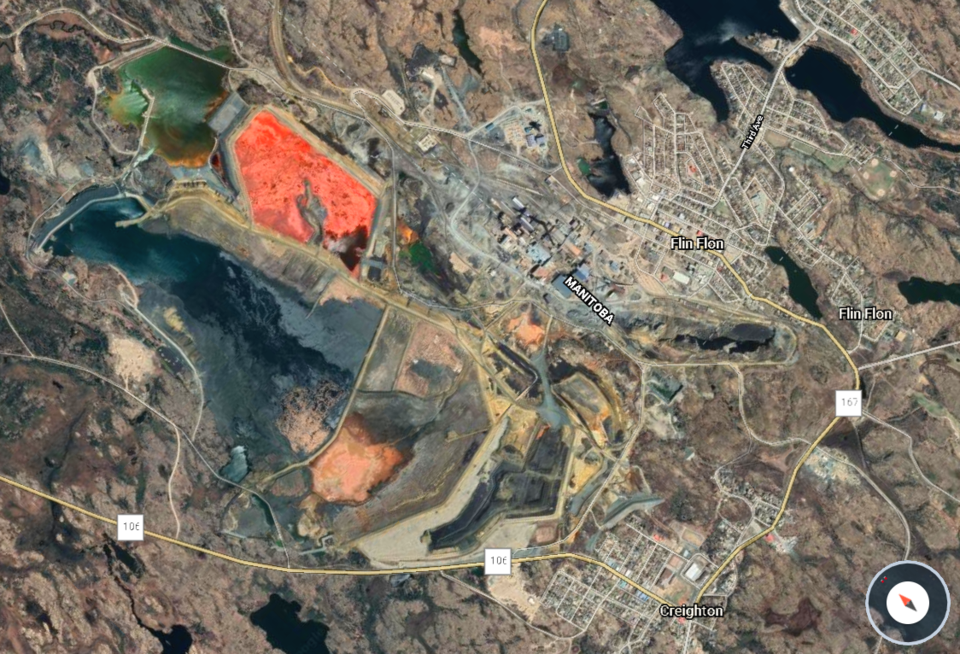Hudbay’s next Flin Flon project might be right under its nose. The company is moving ahead with early plans that could lead to mining out its own tailings facility, pulling almost a hundred years’ worth of wasted mineral value out of the ponds.
Hudbay representatives spoke about the tailings plan and other local company issues, including the status of the Trout Lake dam and selenium levels found in fish downstream from the tailings facility, during a public information meeting Nov. 27 at the Flin Flon Community Hall. The meeting included the first update in almost a year about the planned tailings extraction project and how it might work.
The Flin Flon-area tailings facility - or, as its known within Hudbay, the Flin Flon Tailings Impoundment System (FFTIS) - was started in 1928, when the company began dumping mine waste into what was formerly Flin Flon Lake. Since then, the facility has become more sophisticated, including several specific areas for different types of waste or processing.
No new waste has been deposited in the facility since 2022, when Hudbay closed down much of their local operations, including the 777 mine and zinc plant. The tailings facility was officially placed on “care and maintenance”, meaning it would still be monitored, meeting the company’s minimal requirement for looking after the facility as set out by provincial and federal law.
Since the 2022 closures, the tailings facility has been looked at by Hudbay as a possible source of cash - after almost a century of dumping materials in the now-mostly drained lake, there may be enough mineral value in the depths for Hudbay to pursue pulling it out and processing it. As of last March, the company had reached a deal with Australian company Cobalt Blue Holdings to process a sample of tailings material from Flin Flon, which led to converting high levels of some material into sulphur.
Almost a hundred million tonnes of total tailings material has been dumped in the facility over the years.
“To date, all of those channels still contain metals that didn’t get fully extracted with the historic processing methods that we use and there’s also pretty high sulphur content in the tailings themselves,” said Trevor Ross, Hudbay’s geotechnical and tailings manager.
“Reprocessing those tailings has the potential to extract all of those residual metals that are still in there and the sulphur as well. The sulphur is actually a big part of the products that would be produced for preprocessing.”
As the current plan goes, Hudbay plans to treat the tailings as two separate projects in the same place - first, processing waste specifically from the zinc plant, then the rest. About six million tonnes of tailings are estimated to have come from ZPL. The specific mineral value of the former ZPL waste is seen as a different product from other parts of the facility.
While Flin Flonners are familiar with sulphur - it was one of the main ingredients in Flin Flon’s infamous “smelter smoke” back in the day, responsible for the smoke’s infamous yellow tint - it has many industrial uses, including in pesticides, fungicides and pesticides, batteries and even in pharmaceuticals and food production.
“You can produce a sulphur product that’s used in other industries. There is a demand for that,” Ross said.
As proposed, processing minerals from the existing tailings would mean three main steps - actually mining the material out first, then processing the materials that are found, then processing the waste, likely back into the facility if possible.
“We would mine the existing tailings stack, but we have to do it in a way that’s safe. We’d have to maintain the geotechnical stability of all those tailings structures, so it’s a bit different from mining in rock. This is basically wet sand - it’s very loose, it’s very saturated,” said Ross.
“It’s not all that solid and it’s going to require some special techniques to do it safely and properly.”
Whether or not Hudbay would require new facilities to process materials from tailings or if existing facilities could be repurposed to do that work is still unknown, but Ross said the company would seek to reuse its existing facilities when possible.
“There’s the actual processing itself with the plant - we’ll have to design that and build that processing plant,” he said.
“We are looking at repurposing, as much as possible, all of the existing assets that are there. The existing assets and the zinc plant, the other facilities within the complex, there’s a lot of equipment and components and buildings that we’ll be able to reuse as part of the process.”
More information is still required before company representatives decide to move ahead with processing tailings. Hudbay has already completed a preliminary economic assessment on the project, but more work will need to be completed. That includes environmental assessments, metallurgical testing and other engineering work, leading to pre-feasibility studies and potentially moving the project ahead. While it is too early to give an exact timeline of when or if the project may enter operation, Ross said the company expects the work to be a long-term project.
“It’s very high-level conceptual and put some numbers against it to see if we thought we had an economically feasible project. We've completed to that level for the main mill tailings,” said Ross.
“We're still in the process of doing that and we’re hoping to have that finished, probably late this year or early into next year - then we'll move on to the next stage with both of those. There’s lots of work still to go.”




